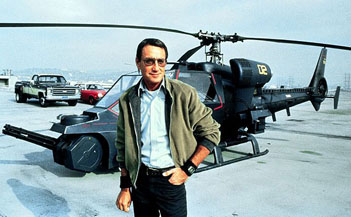Viking Night: Blue Thunder
By Bruce Hall
March 26, 2013
I have to tell you, I hadn't seen this movie since I was a kid, so my expectations were pretty modest going in. As I recall, I spent my entire seventh grade year drawing Blue Thunder all over anything and everything I could put a pencil to. But there's a central theme of liberty vs. security that went right over my head as a boy, and sadly is almost as easy to overlook today. The script, written by Don Jakoby and the legendary Dan O'Bannon (Alien, Total Recall), underwent significant rewrites that - in my opinion - improved it significantly. But the point it tries to make is buried under a maze of overly complex subplots.
The first act focuses mainly on establishing Murphy as a tormented veteran, changed by war in a way that makes civilian life a different kind of hell. The second act centers around the shadowy conspiracy behind the helicopter, and the third act is an eyeball shattering half hour helicopter battle over Los Angeles that is single handedly responsible for me not learning a damn thing in school that year. Somewhere in there is an actual point, which is a surprisingly prescient paranoid freak out over privacy rights and the limits of government authority in the information age - one that remains relevant to this day. But the film is so concerned with justifying Murphy’s actions during that last act that it loses sight of itself a little too often.
Still, Badham does a fine job of infusing his picture with visual intrigue. Much of the story is shot at night, and scenes are consistently lit and set up in a way that makes you feel like a peeping tom. One scene in particular involves Murphy and Lymangood spying on a beautiful woman in her home at night. It’s wrong, of course, but you can’t help but feel stimulated by how luridly inappropriate it is (unless of course, you happen to be a woman). Cinematographer John Alonzo had his work cut out for him, making a film shot almost entirely in the city feel wide open and alive. But he succeeds, and his handheld work in particular makes you feel like you’re somewhere you shouldn’t be, seeing things that aren’t any of your business.
Oh, and did I mention the incredibly badass dogfight that takes up the entire third act and ruined my middle school career? The one with real helicopters weaving between buildings, blasting hot death at each other, blowing up barbecue shacks and making it rain chicken all over downtown Los Angeles? I wish every movie ended this way. But despite its supposed political leanings, most of Blue Thunder is primarily buildup for that explosive climax. Murphy’s PTSD, Cochrane’s dickishness, and even Murphy’s batshit crazy girlfriend (Candy Clark) exist only to play a specific role during the final action sequence. In other words, don’t go in expecting to be enlightened about your civil liberties.
And don’t expect a lot of it to make sense. We never get a satisfactory explanation as to why Cochrane and his pals feel that unleashing a military attack chopper on the city is the only answer to urban crime - especially puzzling when people start dying because of it. We’re never told why their first choice for test pilot was a burned out veteran who wakes up in the middle of the night screaming Vietnamese. And nobody ever mentions the hundreds of innocent people who must surely have been killed during that spectacular final battle. But at the end of the day, Blue Thunder is a slightly visionary, somewhat flawed but highly entertaining action flick that still holds up pretty well today. It’s not enough to overcome the horror of Googling yourself but it’s a great way to kill an afternoon, and if you’re an aging Gen X-er like me, it’s a great way to relive your childhood.
Now if you’ll excuse me, I have to go draw some helicopters.
Continued:
1
2
|
|
|
|




